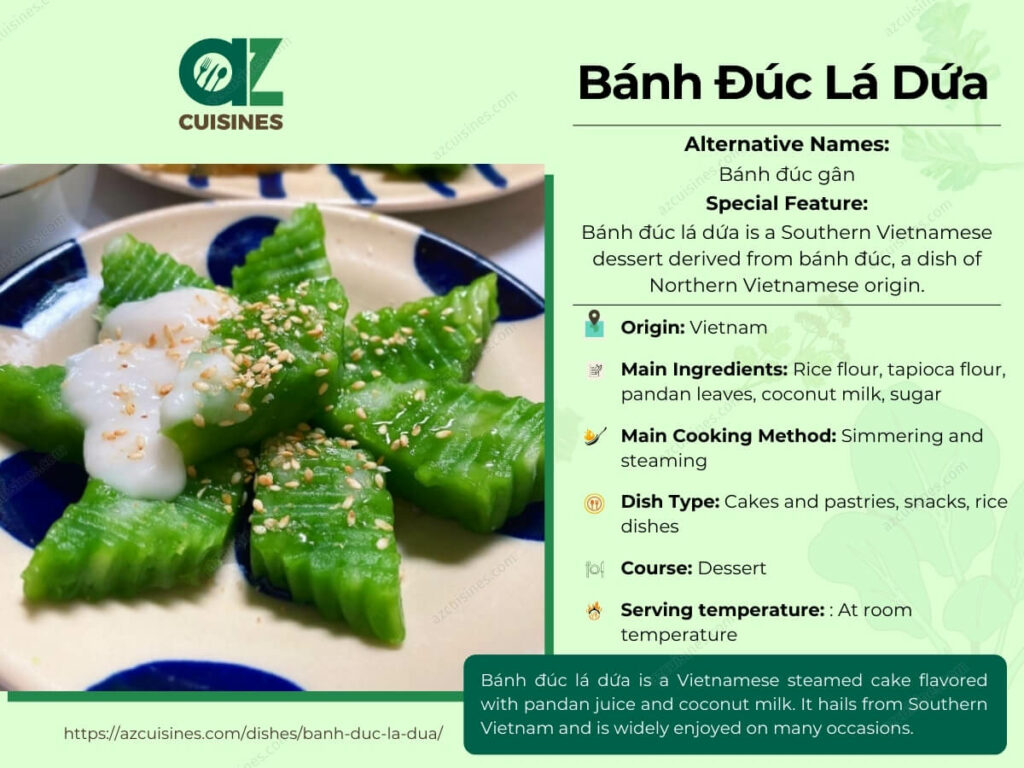Bánh Đúc Lá Dứa: Basic Information
Pronunciation
Alternative Name(s)
Dish Type
Course
Mealtime
Popular Variations
Bánh Đúc Lá Dứa: Ingredients and Preparation
Main Ingredients
Main Cooking Method
Preparation Process
Bánh Đúc Lá Dứa: A Deep Dive
Cultural Significance
Taste
Texture
Aroma
Color
Serving Style
Serving Temperature
Accompaniment
Occasions
Seasons
Special Diets
Calories
Popularity
Popular Similar Dishes
- Bánh Da Lợn
- Kue Lapis
- Khanom Chan
Popular Dining Area
Bánh đúc lá dứa, literally “molded cake with pandan,” is a Vietnamese dessert popular in the southern region, especially in the Mekong Delta.
It is also called bánh đúc gân (“veined bánh đúc”) since this sweet treat sports lines of color like veins in marble. Can Tho City and Ho Chi Minh City offer many must-try shops for bánh đúc lá dứa.
Bánh đúc lá dứa is the sweet take on bánh đúc, a traditional Vietnamese steamed cake made from rice flour or tapioca flour. However, bánh đúc can be paired with savory foods and condiments, whereas bánh đúc lá dứa is mainly served as a dessert, snack, and street food.
Stay tuned since I will discuss how bánh đúc lá dứa is made, followed by its positive and negative traits. Next, I will delve into popular concerns and similar dishes of bánh đúc lá dứa.
Key Points
How Is Bánh Đúc Lá Dứa Prepared?
Making bánh đúc lá dứa usually requires the following 5 steps:
Step 1: Preparing the Dough Mixtures
Puree pandan leaves and strain the juice. Mix rice flour and tapioca flour in water. Divide the dough in half. Combine half the dough with coconut milk and blend the other half with pandan juice.
Step 2: Simmering the Dough Mixtures
Bring water to a boil, turn down the heat, and add the dough with coconut milk. Simmer and stir constantly. Repeat the process with the pandan juice-mixed dough portion.
Step 3: Steaming Bánh Đúc Lá Dứa
Pour the two dough portions into a mold. Blend them well. Steam the mixture.
Step 4: Making Sugar Syrup and Coconut Milk Sauce
Cook sugar (preferably palm sugar) and ginger in water over medium heat. Simmer coconut milk with tapioca starch and sugar over medium heat.
Step 5: Serving Bánh Đúc Lá Dứa
Refrigerate the cake for a few hours (optional). Cut the cake into small pieces. Drizzle sugar syrup and coconut milk sauce over them. Garnish with sesame seeds.
You’re now well-versed in how to prepare bánh đúc lá dứa, but do you know about its upsides and downsides? Read on to find out!
Pros and Cons of Eating Bánh Đúc Lá Dứa
Bánh đúc lá dứa has the advantages and disadvantages below:
Pros
Cons
After learning about the strengths and weaknesses of bánh đúc lá dứa, why don’t you check out other aspects of this delicious dessert?





Truc Tran (Kris)
Senior Food Editor
Expertise
Home Cooking, Meal Planning, Recipe Development, Baking and Pastry, Food Editor, Cooking-video Maker, Vietnamese Food Evaluation Expert
Education
Truc Tran (Kris), an experienced food writer and editor, is great at exploring and describing global cuisines, from simple street food to fancy dining. In her writing, she skillfully mixes different flavors, cooking methods, and culinary traditions, showing the unique character of various cultures through their food and drinks. On azcuisines.com, Kris highlights her knowledge, especially in Asian cuisine and worldwide traditional dishes.